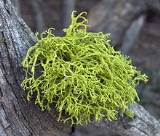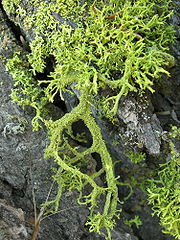
Letharia vulpina
Encyclopedia
Letharia vulpina, commonly known as the wolf lichen, is a fruticose lichen
ized species of fungus in the family Parmeliaceae
. It is bright yellow-green, shrubby and highly branched, and grows on the bark of living and dead conifers in parts of western and continental Europe, the Pacific Northwest and northern Rocky Mountains of Western North America. This species is somewhat toxic to mammals due to the yellow pigment vulpinic acid
, and has been used historically as a poison for wolves and foxes. It has also been used traditionally by many native North American ethnic groups as a pigment source for dyes and paints.
color, although the color will fade in drier specimens. Its dimensions are typically 2 to 7 cm (0.78740157480315 to 2.8 in) in diameter. The vegetative reproductive structures soredia and isidia are present on the surface of the thalli, often abundantly.

within 12 minutes of thawing. It was also able to start photosynthesis while rewarming, still at below-zero temperatures (°C), suggesting that it may remain active during winter.
.
The brightly colored fruiting bodies are popular in floral arrangements.

, Miscellaneous Tracts Relating to Natural History, Husbandry and Physics (London, 1759). According to British lichenologist Annie Lorrain Smith
, reindeer carcasses were stuffed with lichen and powdered glass, and suggests that the sharp edges of the glass would make the animals' internal organs more susceptible to the effects of the lichen poison. However, it is known that the lichen itself is also effective—powdered lichen added to fat and inserted into reindeer carcasses will also be fatal to wolves that consume it. The toxic chemical is the yellow dye vulpinic acid
, which is poisonous to all meat-eaters, but not to mice and rabbits.
Lichen
Lichens are composite organisms consisting of a symbiotic organism composed of a fungus with a photosynthetic partner , usually either a green alga or cyanobacterium...
ized species of fungus in the family Parmeliaceae
Parmeliaceae
The Parmeliaceae is a large and diverse family of Lecanoromycetes. With over 2000 species in roughly 87 genera, it is currently regarded as the largest family of lichen forming fungi...
. It is bright yellow-green, shrubby and highly branched, and grows on the bark of living and dead conifers in parts of western and continental Europe, the Pacific Northwest and northern Rocky Mountains of Western North America. This species is somewhat toxic to mammals due to the yellow pigment vulpinic acid
Vulpinic acid
Vulpinic acid is a naturally occurring pulvinic acid derivative found in several lichen species, as well as some non-lichenized fungi. It was first isolated in 1925. It is bright yellow, and relatively toxic.-Occurrence in Lichen:...
, and has been used historically as a poison for wolves and foxes. It has also been used traditionally by many native North American ethnic groups as a pigment source for dyes and paints.
Description
The thallus, or vegetative body, has a fructicose shape — that is, shrubby and densely branched — and a bright yellow to yellow-green, or chartreuseChartreuse (color)
Chartreuse is a color halfway between yellow and green that was named because of its resemblance to the green color of one of the French liqueurs called green chartreuse, introduced in 1764...
color, although the color will fade in drier specimens. Its dimensions are typically 2 to 7 cm (0.78740157480315 to 2.8 in) in diameter. The vegetative reproductive structures soredia and isidia are present on the surface of the thalli, often abundantly.

Physiology
Like most lichens, L. vulpina is highly tolerant of freezing and low temperatures. In one set of experiments, the lichen was able to reactivate its metabolism after 15 hours of cold storage and resume photosynthesisPhotosynthesis
Photosynthesis is a chemical process that converts carbon dioxide into organic compounds, especially sugars, using the energy from sunlight. Photosynthesis occurs in plants, algae, and many species of bacteria, but not in archaea. Photosynthetic organisms are called photoautotrophs, since they can...
within 12 minutes of thawing. It was also able to start photosynthesis while rewarming, still at below-zero temperatures (°C), suggesting that it may remain active during winter.
Habitat
L. vulpina prefers to grow in high elevations, just above the tree line in the Pacific Northest. It is often abundant on exposed branches that have lost their bark. In old, moist forests it is typically found in drier areas. This species has an intermediate air pollution sensitivity. In the Rocky Mountains, letharia species are found in ponderosa forests at the prairie-forest boundary at relatively low elevations though medium and high elevation douglas fir and lodgepole pine forests.Uses
Some Plateau Indian tribes used wolf lichen as a poultice for swelling, bruises, sores, and boils, and boiled it as a drink to stop bleedingBleeding
Bleeding, technically known as hemorrhaging or haemorrhaging is the loss of blood or blood escape from the circulatory system...
.
The brightly colored fruiting bodies are popular in floral arrangements.
Dyeing
The Klamath Indians in California soaked porcupine quills in a chartreuse-colored extract of Letharia vulpina that dyed them yellow; the quills were woven into the basket patterns.
Poison
The use of this species for poisoning wolves and foxes goes back at least hundreds of years, based on the mention of the practice in Christoph Gedner's "Of the use of curiosity", collected in Benjamin StillingfleetBenjamin Stillingfleet
Benjamin Stillingfleet was a botanist, translator and author. He is said to be the first Blue Stocking, a phrase from which is derived the term bluestocking now used to describe a learned woman.-Life:...
, Miscellaneous Tracts Relating to Natural History, Husbandry and Physics (London, 1759). According to British lichenologist Annie Lorrain Smith
Annie Lorrain Smith
Annie Lorrain Smith was a British lichenologist whose Lichens was an essential textbook for several decades...
, reindeer carcasses were stuffed with lichen and powdered glass, and suggests that the sharp edges of the glass would make the animals' internal organs more susceptible to the effects of the lichen poison. However, it is known that the lichen itself is also effective—powdered lichen added to fat and inserted into reindeer carcasses will also be fatal to wolves that consume it. The toxic chemical is the yellow dye vulpinic acid
Vulpinic acid
Vulpinic acid is a naturally occurring pulvinic acid derivative found in several lichen species, as well as some non-lichenized fungi. It was first isolated in 1925. It is bright yellow, and relatively toxic.-Occurrence in Lichen:...
, which is poisonous to all meat-eaters, but not to mice and rabbits.

